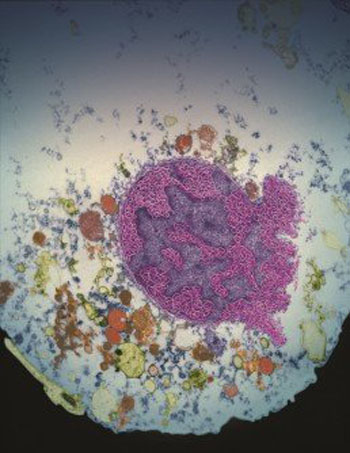Critical Final Step in Parthanatos Pathway Identified
By LabMedica International staff writers
Posted on 18 Oct 2016
A team of neurological disease researchers has identified the enzyme responsible for the last link in a chain of molecular steps that constitutes the cell death pathway called parthanatos.Posted on 18 Oct 2016
Parthanatos is a form of programmed cell death that is distinct from other cell death processes such as necrosis and apoptosis. While necrosis is caused by acute cell injury resulting in traumatic cell death, and apoptosis is a highly controlled process signaled by apoptotic intracellular signals, parthanatos is caused by the accumulation of PAR (Poly(ADP-ribose)) and the nuclear translocation of apoptosis-inducing factor (AIF) from mitochondria. Parthanatos is also known as PARP-1 dependent cell death. The PARP-1 (Poly(ADP-ribose) polymerase-1) enzyme mediates parthanatos under circumstances in which it becomes over-activated in response to extreme genomic stress and synthesizes PAR, which causes nuclear translocation of AIF. Parthanatos is involved in several well-known diseases including Parkinson’s disease, stroke, heart attack, and diabetes.

Image: The nucleus of a cell undergoing parthanatos (Photo courtesy of Yingfei Wang and I-Hsun Wu, Johns Hopkins University).
Investigators at Johns Hopkins University (Baltimore, MD, USA) reported in the October 7, 2016, issue of the journal Science that they had used two sequential unbiased screens, including a human protein array and a small interfering RNA screen to discover that macrophage migration inhibitory factor (MIF) bound AIF and was required for parthanatos. In the presence of magnesium or calcium ions, MIF possessed both 3′ exonuclease and endonuclease activity. It bound to 5′ unpaired bases of single-stranded DNA with stem loop structure and cleaved its 3′ unpaired bases. These nuclease activities allowed MIF to cleave genomic DNA into large fragments.
Depletion of MIF markedly reduced cell death induced by N-methyl-d-aspartate (NMDA) receptor–activated glutamate toxicity in primary neuronal cultures as well as DNA damage caused by N-methyl-N′-nitro-N-nitrosoguanidine (MNNG) or focal stroke in mice. Mutating key amino acid residues in the nuclease domain of MIF eliminated its nuclease activity and prevented parthanatos. In addition, disrupting the AIF and MIF interaction prevented the translocation of MIF from the cytosol to the nucleus and protected against parthanatos. . Therefore, targeting MIF nuclease activity may offer an important therapeutic opportunity for a variety of disorders with excessive PARP-1 activation.
"We found that AIF binds to MIF and carries it into the nucleus, where MIF chops up DNA," said senior author Dr. Ted Dawson, director of the institute for cell engineering at Johns Hopkins University. "We think that is the final execution step in parthanatos. I cannot overemphasize what an important form of cell death it is; it plays a role in almost all forms of cellular injury. We are interested in finding out whether MIF is also involved in Parkinson's, Alzheimer's, and other neurodegenerative diseases. If so, and if an inhibitor of MIF proves successful in testing, it could have implications for treating many conditions."
Related Links:
Johns Hopkins University














